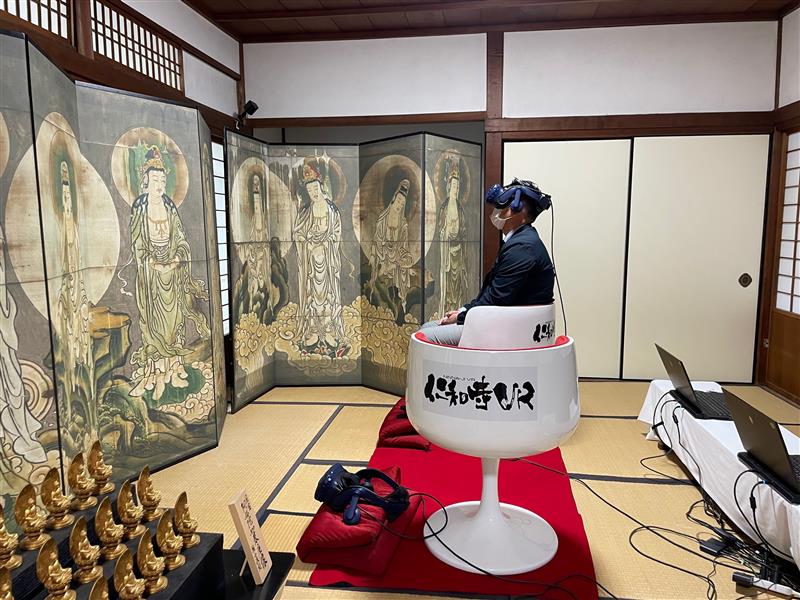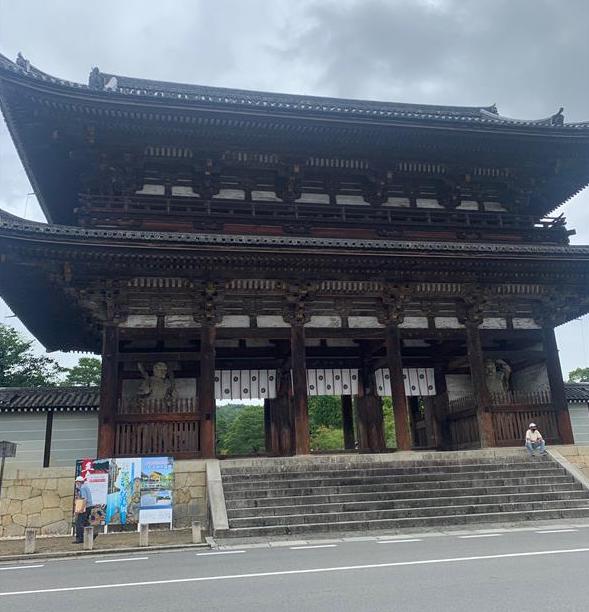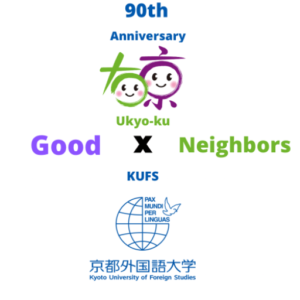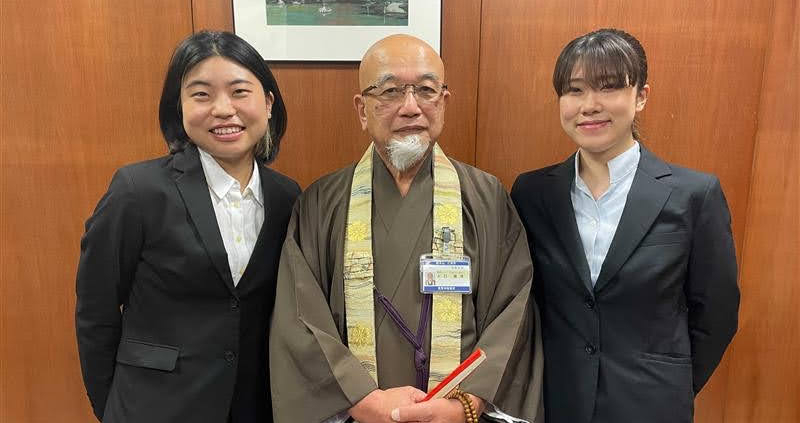[Ukyo in Action] Ninnaji Temple
Interviewers/Authors: Chiharu Miyamoto, Ruka Sasaki
The Reverend Ryujun Oishi
Ninnaji Temple was founded in 888 AD and is now the head temple of the Omuro School of the Shingon Sect of Buddhism. There are historical buildings that were built in the Edo era such as Gojunoto Pagoda and Niomon Gate and it was registered as a UNESCO World Heritage site in 1994. On the day of the interview, we first visited the Ninnaji Temple complex, guided by Rev. Ryujun Oishi, a senior priest. We were able to listen to many interesting stories, such as certain information on Emperor Hirohito’s connection to the temple around the end of World War II, the story of wood used in the main building, and the story of the pictures painted on sliding paper doors (fusuma). After the interview, we were also able to experience a virtual reality exhibition showcasing the temple’s national treasures and became so excited to see the Buddha statues, national treasures and important cultural properties, up so close on VR. We asked about the digitization efforts and what role Ninnaji Temple plays in Ukyo Ward. In addition to Rev. Oishi, we were able to speak with Rev. Gishin Kanazaki, the section manager of Ninnaji.
― How long have you been working at Ninnaji Temple?
Rev. Oishi: I have been working as both a chief Buddhist priest and a civil servant since I was in my twenties. I retired in my sixties and then in 2014 when I was 66 the current head priest of Ninnaji Temple, who was a classmate of mine from university, asked me to come to Ninnaji to work.
― What is your main role at the temple?
Rev. Oishi: I’m primarily a finance manager, but I’m also in charge of the maintenance of the landscape, and work in visitor services at Ninnaji Temple. At present, it is an important task to rebuild our finances due to the ongoing situation with Covid-19.
― What kind of place is Ninnaji Temple for residents living in Ukyo Ward?
Rev. Oishi: We try to provide a place for people to feel at ease and I want everyone to relax. I also would like to create an environment where people can talk with monks to ease their concerns.
― In what ways do you think Ninnaji Temple can contribute to the local community in the future?
Rev. Oishi: I think we should inform people in Ukyo Ward more about Ninnaji Temple so they can feel connected with the temple complex. During the light up events in spring and autumn, we schedule a special day and invite Ukyo Ward residents to come for free, but this service is not well known yet. We also provide a space in the temple for people to come together to eat bentos (boxed lunches) and it is a good way to develop strong connections with the local community. We hope to create more opportunities to connect with the residents of Ukyo-ku.
― Please tell us about “Cleaning Volunteers”.
Rev. Oishi: “Cleaning Volunteers” is the name of a project in which volunteers clean the temple grounds and the Omuro Pilgrimage trail, which is a 2-hour walking course behind Ninnaji Temple. Our goal is to organize 100 volunteers, and currently we have between 20 and 40 people registered. About 20 students from Ritsumeikan University volunteer with the project and the rest are general volunteers. We would like more people to join this project.
― In addition to Ninnaji Temple, Kyoto has many historic temples and tourist destinations. However, in some places multilingual information is lacking, and this is an issue Kyoto is facing due to the increase of foreign tourists. What is Ninnaji Temple doing to provide services for foreign visitors?
Rev. Oishi: We have received a grant from the government to assist us in providing multilingual support in languages such as English, Chinese, French and Korean. Many temples and sites in Kyoto have the latest digital technology, and at Ninnaji Temple visitors can use their smartphones to access QR codes on various signs which provide enhanced 3D maps and information in Japanese, English, Chinese, and Korean.

― We saw the map of the precincts of Ninnaji Temple on the website and thought it was rare that there was a universal access version for people in wheelchairs or with strollers. Could you tell us how you came up with the idea of making these maps?
Rev. Oishi: The universal access version was created with a grant from the Japanese government in cooperation with Kyoto University.
Rev. Kanazaki: Because this temple complex is so large, we made maps to assist first-time visitors. Moreover, we are currently taking measures to increase the number of younger visitors to the temple. For example, for the design of the temple’s brochure we used three-dimensional images and an image of a cloudy sky instead of a blue sky on the cover. In addition, we regularly hold art exhibitions in spaces around the complex. I hope that these efforts will gain the recognition of young people and will lead to an increase in the number of visitors to the temple in the future.

― What do you consider are the most important things necessary to continue the legacy and the history of Ninnaji Temple?
Rev. Oishi: We continuously pray for peace and happiness all over the world. I hope we are creating an environment at Ninnaji Temple where everyone can feel happy with their life, as well as experience a sense of peace while visiting Ninnaji Temple.



